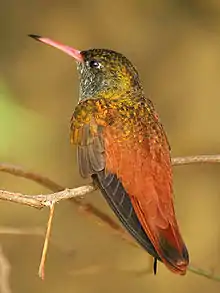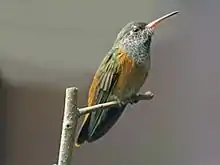Amazilia hummingbird
The amazilia hummingbird (Amazilis amazilia) is a hummingbird in the family Trochilidae. It is the only species placed in the genus Amazilis.
| Amazilia hummingbird | |
|---|---|
 | |
 | |
| Scientific classification | |
| Kingdom: | Animalia |
| Phylum: | Chordata |
| Class: | Aves |
| Order: | Apodiformes |
| Family: | Trochilidae |
| Tribe: | Trochilini |
| Genus: | Amazilis Gray, 1855 |
| Species: | A. amazilia |
| Binomial name | |
| Amazilis amazilia (Lesson, 1827) | |
The amazilia hummingbird occurs in western Peru and south-western Ecuador. It is generally common, and can regularly be seen even in major cities such as Lima and Guayaquil. It prefers dry, open or semi-open habitats, but also occurs in forest. In its range it is easily recognized by the combination of a black-tipped red bill and mainly rufous underparts. It is a territorial species.[2]
Its diet consists of small insects and nectar of flowering Erythrina, Psittacanthus, and other flower corollas of medium length.[3] It can spend roughly 80% of its time resting, using the rest of its time to forage, hunt, and defend its territory (often against Coereba flaveola).[2] It breeds year round with cup like nests only ~3cm above the ground.[3]
The amazilia hummingbird was formerly placed in the genus Amazilia. A molecular phylogenetic study published in 2014 found that the genus Amazilia was polyphyletic.[4] In the revised classification to create monophyletic genera, the amazilia hummingbird was moved to the resurrected genus Amazilis that had been introduced in 1855 by George Gray.[5][6]
Some ornithologists have proposed that the subspecies Amazilis amazilia alticola, the Loja hummingbird, should be treated as a separate species.[7][8]
References
- BirdLife International (2012). "Amazilia amazilia". IUCN Red List of Threatened Species. 2012. Retrieved 26 November 2013.CS1 maint: ref=harv (link)
- Calviño-Cancela, M. (September 2006). "Time-activity budgets and behaviour of the Amazilia hummingbird, Amazilia amazilia (Apodiformes: Trochilidae) in an urban environment". Revista de Biología Tropical. 54 (3): 873–878. doi:10.15517/rbt.v54i3.13684. ISSN 0034-7744.
- "Amazilia Hummingbird (Amazilia amazilia)". www.hbw.com. Retrieved 2019-05-24.
- McGuire, J.; Witt, C.; Remsen, J.V.; Corl, A.; Rabosky, D.; Altshuler, D.; Dudley, R. (2014). "Molecular phylogenetics and the diversification of hummingbirds". Current Biology. 24 (8): 910–916. doi:10.1016/j.cub.2014.03.016.
- Stiles, F.G.; Remsen, J.V. Jr.; Mcguire, J.A. (2017). "The generic classification of the Trochilini (Aves: Trochilidae): Reconciling taxonomy with phylogeny". Zootaxa. 4353 (3): 401–424. doi:10.11646/zootaxa.4353.3.
- Gill, Frank; Donsker, David; Rasmussen, Pamela, eds. (July 2020). "Hummingbirds". IOC World Bird List Version 10.2. International Ornithologists' Union. Retrieved 7 January 2020.
- Weller, André-Alexander (2000-01-01). "Biogeography, geographic variation and habitat preference in the Amazilia Hummingbird,Amazilia amazilia Lesson (Aves: Trochilidae), with notes on the status ofAmazilia alticola Gould". Journal für Ornithologie. 141 (1): 93–101. doi:10.1007/BF01651776. ISSN 1439-0361.
- Krabbe, Niels (September 2009). "A new subspecies of Amazilia Hummingbird Amazilia amazilia from southern Ecuador". ResearchGate. Retrieved 2019-05-24.
| Wikimedia Commons has media related to Amazilia amazilia. |
| Wikispecies has information related to Amazilia amazilia. |
